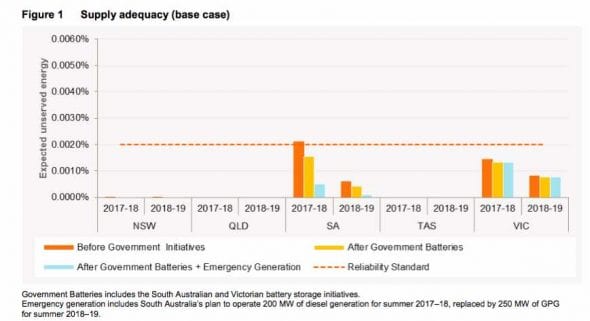South Australian consumers will be hoping that the state government succeeds in getting its proposed 100MW of battery storage in place this summer, after the Australian Energy Market Operator warned it would be critical in dealing with extreme heat events.
In the first of a new Energy Supply Outlook publication, the AEMO says all states should meet their reliability standards this coming summer, but warns of “a risk of electricity supply falling short of demand, especially in extreme conditions”.
The most exposed were South Australia and Victoria, as well as New South Wales. Both South Australia and NSW experienced enforced “load shedding” in last summer’s heatwave.
AEMO says the greatest risk of load shedding will occur on extremely hot summer afternoons and evenings, and the combination of low wind and solar output, unexpected interruptions to coal or gas generation, or there are network issues.
In South Australia, it says, all existing generation capacity must be available and operating in such events, including the Pelican Point gas station at full service, which sat idle in February’s load shedding, as well as the new battery storage and diesel generation contracted for by the government must be available as planned.
This graph shows the importance of battery storage installations which are due in both South Australia and Victoria by the coming summer. In S.A, it brings the standard below the 0.002 per cent reliability standard.
South Australia is currently awaiting final bids from shortlisted candidates for its tender for 100MW and 100MWh of battery storage, although AEMO put this at 200MWh of storage. Victoria is also tendering for 40MW and up to 100MWh of battery storage in two locations in the west of the state.
Other measures and investments that could help alleviate problems this summer include the 500MW of wind and solar projects that will come online across the country, and the 200MW of temporary diesel generation in South Australia, along with 100MW of demand management being procured by AEMO itself.
It is also working to ensure that generators have enough fuel – water for hydro plants, coal for coal generators and gas for gas generators. It may seem obvious, but each of these types of generation have found themselves short of their crucial fuel source at various times in the past two summers.
AEMO says the planned return of three mothballed gas fired generators (Tamar, Swanbank and) should ease supply, but in the worse case coal could be in short supply in NSW, and sufficient gas may not be available.
The gas issue is the most problematic, but AEMO says that it is working with the LNG industry to ensure supplies, or at least provide some visibility on supply.
Zibelman wants to introduce a smarter way of dealing with demand peaks and supply shortages, focusing on the demand side of the equation (battery storage, demand management) rather than the traditional approach of building new capacity.
But this summer appears a matter of grabbing whatever capacity or program that can be obtained, including diesel gen-sets, mothballed gas plants, new battery storage, and incentives for large and small users to cut demand at critical times.












